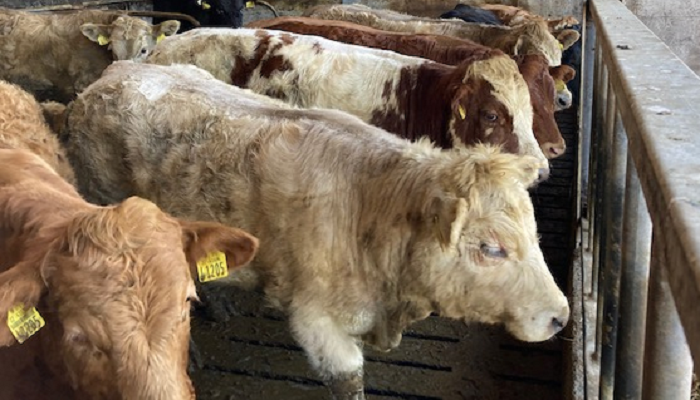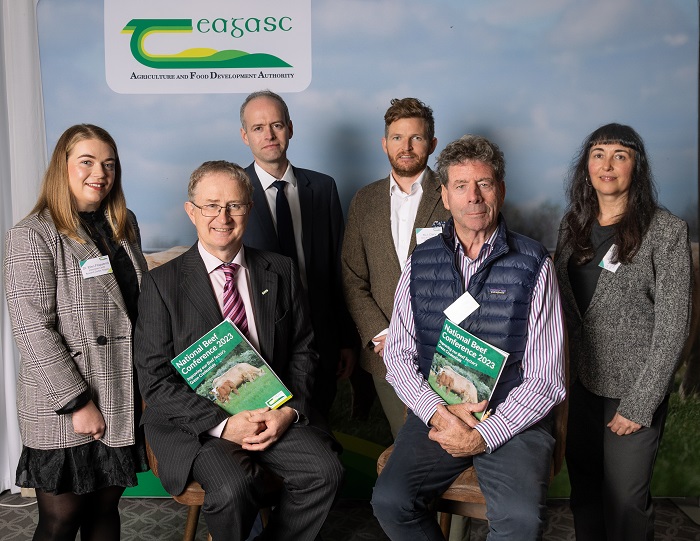22 November 2023
Controlling IBR – the first step is knowing your herd’s status

IBR is a highly infectious virus that not only has implications on animal performance, but its presence within Irish herds may cause disruptions when accessing key live export markets with Irish cattle in the future.
Presenting from this year’s Teagasc National Beef Conference, Dr Maria Guelbenzu, Programme Manager for BVD and IBR with Animal Health Ireland, noted that IBR is a primary cause of mortality in young cattle in Ireland.
A multi-factorial disease, outbreaks are associated with animal factors – such as immunity, age, sex and genetics – the environment in which the animals are housed, and other viruses and bacteria that may create an avenue for the virus to enter the animal’s system.
Commenting on the clinical signs of IBR, Maria said: “Presentation is variable and this means that some animals will have very mild disease and some animals will have severe disease. Typically, they are going to have increased temperature, with that comes dullness and a loss of appetite and the signs are really concentrated within the upper respiratory tract.”
Other symptoms include redness of the nose and eyes and discharge from the nose. Although the virus generally runs its course over 8-10 days, mortalities can occur, while another issue is abortion; milk drops are witnessed in dairy cows.
Maria added: “This disease has an obvious health and welfare impact on animals. Animals that go through a bad bout of respiratory infection will not be as productive; they will not put on the same weight and they won’t be able to reach reproductive age as well.”
Additionally, an outbreak of IBR is associated with a cost. Not only does this include reduced performance, but the veterinary costs associated with treating infected animals also have to be factored in. IBR also has consequences for pedigree breeders, as antibody positive IBR animals cannot have semen collected for use in AI stations.
Silent carriers
Animal Health Ireland estimates that 75-80% of herds in Ireland have at least one positive animal for IBR. Although taken from old work, it hopes that testing completed through the National Beef Welfare Scheme will paint a clearer picture of the prevalence of IBR within Irish suckler herds.
This testing programme will also serve to identify latently-infected animals – animals which have experienced an IBR infection in the past. Although these animals have developed immunity, the virus becomes latent or lies dormant in their system. In times of stress, Maria explained, the virus might reactivate and these animals – although they appear totally normal – are capable of producing virus and infecting others.

Pictured at the Teagasc National Beef Conference from left to right are: Dr Ellen Fitzpatrick, Teagasc; Professor Frank O’Mara, Teagasc Director; Dr Paul Crosson, Beef Enterprise Leader, Teagasc Grange; Mr MJ Clery, Host of Country Life, Midlands 103; Mr Liam Herlihy, Chairman of the Teagasc Authority; and Dr Maria Guelbenzu, Programme Manager for BVD and IBR with Animal Health Ireland.
Controlling IBR at farm level
Many farmers have or will be receiving results of IBR testing completed under the National Beef Welfare Scheme. This, Maria explained, will allow farmers to identify if IBR is circulating within their herds. From there, a plan can be put in place to prevent its future spread and ultimately achieve its control.
“The first step in control is to know your herd’s status because that is very important in terms of the biosecurity that you will be able to or that you should implement. The results of snapshot testing will allow you to review herd biosecurity and vaccination programmes.”
Farmers also need an awareness of biosecurity and the higher risk activities that can aid the spread of this virus. Such activities, Maria said, include introducing latently-infected animals into your herd through purchasing or the mixing or animals from different sources. The virus may also spread through people inadvertently carrying the virus onto your farm.
From the results generated from the National Beef Welfare Scheme, Maria added: “When you have a negative or positive result, the first thing is we can estimate the within herd prevalence or the proportion of animals actually infected within your herd.
“Then we can have a look at individual animal level. It is important to look at which cohort is positive. If you have younger positive animals, it is because the virus has been circulating recently. If the animals are older, it’s an older infection.”
Depending on the prevalence of IBR within your herd, a vaccination programme may be required. Maria also highlighted some important points in relation to the implementation of an IBR vaccination programme with marker vaccines. Key points include:
- Very useful to reduce the clinical signs of IBR and reduce virus shedding following infection and reactivation;
- Vaccines do not prevent field viruses from causing limited infections;
- Vaccinating the breeding herd will help reduce the level of reactivation and new infections in infected herds, and in consequence reduce the number of IBR-positive animals with time in a herd
- Vaccinating only young stock will not achieve this effect;
- Bulls with potential for use as AI sires must not be vaccinated.
IBR eradication programme
Maria also touched briefly on an IBR eradication programme. Giving a flavour of what an IBR scheme would look like, she said the initial phase would be a reduction phase, to reduce the prevalence of IBR, using bulk tank milk testing, snapshot testing and vaccination. This would allow for the identification of the first disease free herds.
From there, an eradication phase would be introduced, where Ireland would look to have complete alignment with the legislation and to have approval of the programme at EU level. The final phase would be monitoring, which will occur once Ireland is recognised as being IBR free by the EU. At this point, vaccination would cease.
